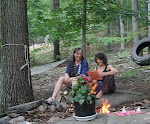Two Pastors, Two Ministries, One Church And An Experience Of Awe
How did congregational conversations lead directly to money in the bank?
This is the story I am sure you would most like to hear. People's ears perk up when I suggest that this is what occurred that tangibly affirmed the power of the "awe" I witnessed at Centennial.
So -- "tell us, Anastasia, how can simply talking among congregants – in a facilitated, organiz ed fashion -- lead directly to money in the bank?
ed fashion -- lead directly to money in the bank?
(A welcome corollary (for me) is -- "Anastasia, will you next help us do the same?)
Though I am still connecting the dots myself, I assure you that "money in the bank" is what resulted.
How fun!
I saw it with my very own, beautiful new eyes. I promise to keep you posted as my wrap-up of the project -- and -- its accompanying questions are answered.
However, the general, overall answers to the "how" of Centennial's success are tied to the power of conversation, geared toward bringing two very polarized congregation, operating in one church, into unity with one another. It was a challenging endeavor. And, both congregations rose to the occasion (with many stories yet to be shared, both poignan,t and profound, from the intense adventure we had.
The most telling results of our efforts were observable in the following ways --
1. Systemic change; and
2. Organizational dysfunction set aright.
Maybe that's all anybody really needs to know.
We, at the New Horizons Small "Zones of Peace" Project have a successful model designed to accomplish just these outcomes!
Called "Campfire Conversations" for our metaphoric climb to the peak of the Mountain Of Awe, they have more frequently been identified as "Coffee House Conversations." At Centennial we called them the "Saving Centennial Conversations."
Point of interest: This highly successful model of the New Horizons Small "Zones of Peace" project originated out of my/our partially successful, partially abortive efforts to reconcile differences between local Jews and Muslims.
The story of the models evolution out of that controversy is the essence of my manuscript in progress -- "The Middle East Crisis In My Backyard."
I will be posting excerpts frothat mss in progress in posts to follow. The essence of that controversy is almost exactly replicated now in what we are seeing regarding the NYC mosque controversy. How can we now use what we have learned?
Please stay tuned in -- or -- whatever they call it these days.











